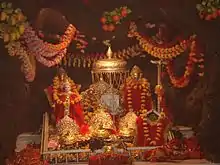Vaishno Devi
Vaishno Devi (also known as Mata Rani, Trikuta, Ambe and Vaishnavi) is a manifestation of the Hindu Mother Goddess, Devi. The words "Maa" and "Mata" are commonly used in India for mother, and thus are often heavily used in connection with Vaishno Devi. Vaishnavi was formed from the combined energies of Kali, Lakshmi, and Saraswati.
| Vaishno Devi | |
|---|---|
Goddess of hills | |
 Goddess Vaishno Devi | |
| Other names | Vaishnavi, Mata Rani, Ambe, Trikuta, Sherawali, Jyotawali, Pahadawali |
| Devanagari | वैष्णो देवी |
| Affiliation | Saraswati, Lakshmi, Kali |
| Abode | Vaishno Devi Temple, Katra, India |
| Mount | Lion |
| Parents | Ratnakar and Samridhi |
Legend
According to the mythology, during the Treta Yuga (second yuga of Hindu cosmology), evil forces started to threaten the earth. To save herself, Bhumi the mother earth, went to the Trimurti for help. While the three gods were helpless, their consorts — Saraswati, Lakshmi and Parvati (Kali) combined their forces and created a goddess named Vaishnavi. After numerous battles, the goddess defeated evils and was ordered to stay on earth to protect it.[1]
Years after, Vaishnavi was reborn as the daughter of a Brahmin couple. From childhood, the goddess was attracted to Vishnu and decided to marry him. When she grew up, she started to mediate in order to please Vishnu. One day, Rama, an incarnation of Vishnu, came to her. Rama refused to marry her and told that he is searching for his lost wife — Sita. Seeing his devotee in misery, Rama promised her that he will return one day and if she recognise him, then he will marry her. Years later, Rama as an old man came there, but she couldn't recognise him. As a result, Rama again promised her that he will marry her as Kalki, the last avatar of Vishnu.
Temple
See also
References
- Singh, Aruna Balakrishna (1 April 1971). Vaishno Devi. Amar Chitra Katha Pvt Ltd. ISBN 978-81-8482-630-2.
External links
 Vaishno Devi travel guide from Wikivoyage
Vaishno Devi travel guide from Wikivoyage